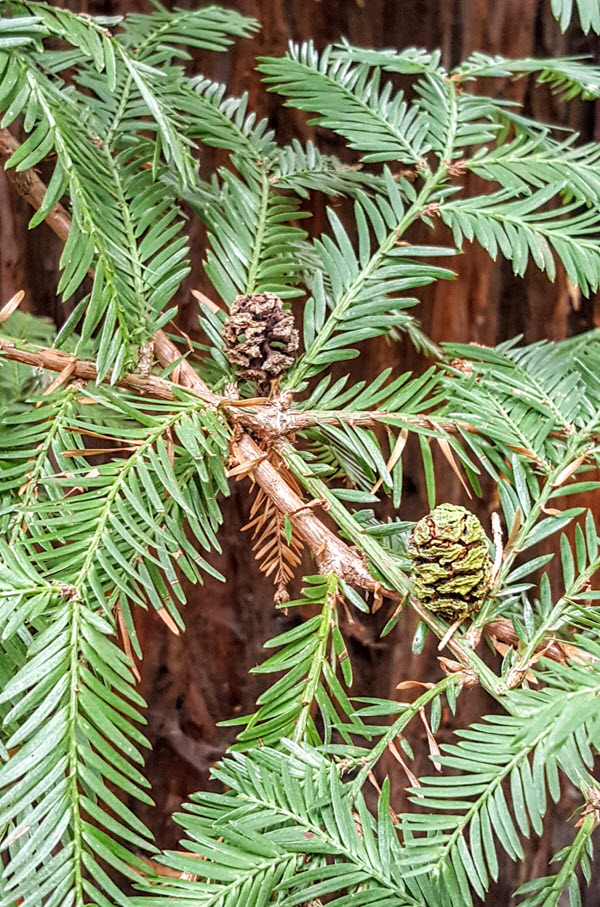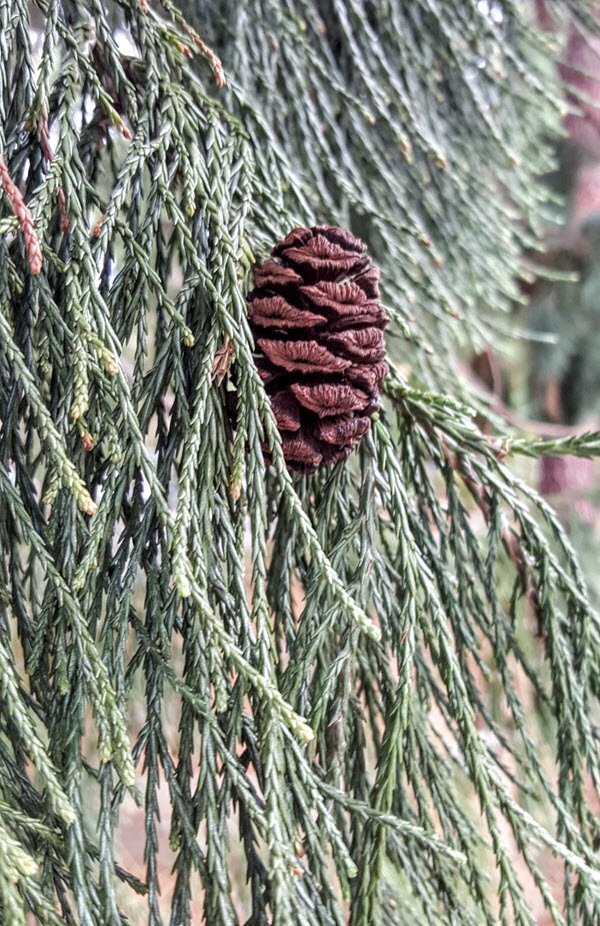
The coast redwood Sequoia sempervirens has different leaves and smaller cones than the giant sequoia
The American or Californian coast redwoods Sequoia sempervirens are still officially regarded as the tallest “tree” in the world with a record tree topping in at 115.5 meters in height in the California Redwood National Park. The other big tree species often confused with the coast redwood is the giant sequoia or Sequoiadendron giganteum which is more known for its immense trunk size and overall mass than its height, although tall it is not as high as the coast redwood. Examples of this one include the so called “drive through tree” where over a century ago some trees had a tunnel bored through their trunks to enable vehicles or carts to move through.
Some would also say that Australia and in particular Tasmania has had, and possibly still has, the world’s tallest trees. The mountain ash Eucalyptus regnans is well represented in Tasmania but also grows to some extent on the Australian mainland in Victoria and south east Australia. More than 140 specimens have been recorded in Tasmania above 85 metres in height with a number of these well over 90 metres. There are old records of Tasmanian trees being felled in the past equaling the height of the redwoods. There are potentially many more out there to discover within the Tasmanian wilderness, so who knows what monsters might still exist.
Some botanical purist’s argue that the current world’s tallest recorded tree, the Coast Redwood, is a gymnosperm,
(essentially a non-flowering cone bearing tree), the mountain ash however is an angiosperm or true flowering tree, so therefore this makes the Australian mountain ash the absolute tallest flowering plant in the world. It should also be noted that the existing heights of the majority of these incredibly tall mountain ash trees may not actually be the original heights of the trees, as over time their tops have been blown out by wind storms, reducing their overall height by many metres.
The possible outcomes from a changing climate
The coast redwoods have lifespans of around 3000 years or more, compared to the mountain ash with a lifespan of around 500 years. Both trees come from forested areas that have good yearly rainfall and often have a forest under-story that consists of ferns, mosses and moisture loving plants. The mountain ash is a Eucalyptus, a characteristic Australian genus that has over time adapted to periods of dry conditions, and the inevitable fires that come with that. Unlike many other Eucalyptus the mountain ash usually dies when a significant fire moves through a forest. Ironically, to exist its seeds need a fertile ash bed and clearance from other forest species to germinate and grow, typical of what it would get after a fire. If the conditions within their natural habitats continue to change and there is a move to drier weather patterns with more frequent fires, these trees could eventually be eliminated from the forests that they have lived in for hundreds of thousands of years. On top of this many large forest trees around the world are currently living close to their maximum safety parameters for managing water stress, this is therefore adding to the ongoing sustainability and survival of these massive giants as climate change takes hold.
Locations to see them
The Royal Tasmanian Botanical Gardens has some of Australia’s best and oldest examples of exotic and native specimen tall trees. We have three mature examples of the Sequoiadendron giganteum or the giant sequoia, which in the wild are typically found in isolated groves around Yosemite in California. Our 40 metre trees can be seen on the entrance drive to the main Domain gate off the lower Domain road and another specimen just past the Chinese garden at the top end of the Gardens pond area. Our trees are more than 130 years old and although old in relation to other cultivated specimens in Australia, they are only babies when compared to the older trees in California, with some there some reaching ages in excess of 3000 years.
We are also lucky to have three mature specimens of the coast redwood Sequoia sempervirens one of which forms part the upper tree canopy at the top end of the Gardens pond area.
Our native mountain ash trees can be found growing naturally in the southern forests near Tahune forest reserve, 60km south of Hobart.
Two excellent articles worth a look include:
“Climbing the world’s tallest flowering tree” by Tasmanian Geographic, which details an expedition to the southern forest giants and includes some great images and wonderful creative sphere view images of the trees themselves.
Also worth a look is the article: “Tasmania’s giant ash trees may be the worlds tallest” That also details the mountain ash trees with an interesting size chart.
Did we really answer the question of “what is the tallest tree?”? Maybe there is no real reason to know?


